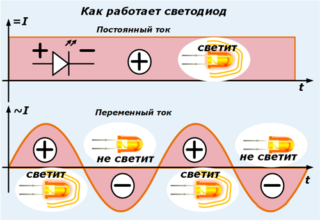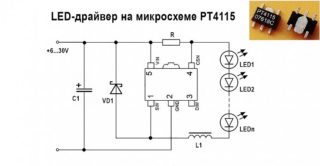It is difficult to do without LEDs when designing electronic equipment, as well as in the manufacture of economical lighting devices. Their reliability, ease of installation and relative cheapness attract the attention of developers of household and industrial lamps. Therefore, many users are interested in circuit solutions for turning on the LED, implying direct supply of phase voltage to it. It will be useful for non-specialists in the field of electronics and electrics to learn how to connect an LED to 220V.
Diode technical features
By definition, an LED, whose circuitry is similar to a conventional diode, is the same semiconductor that passes current in one direction and emits light as it flows. Its working junction is not designed for high voltages, therefore, just a few volts is quite enough for the LED element to light up. Another feature of this device is the need to supply a constant voltage to it, since at alternating 220 Volts the LED will flash at the mains frequency (50 Hertz). It is believed that the human eye does not respond to such blinks and that they do not harm it. But still, according to the current standards, it is necessary to use a constant potential for its operation. Otherwise, special measures must be taken to protect against dangerous reverse voltages.
Most of the samples of lighting equipment, in which diodes are used as lighting elements, are connected to the network through special converters - drivers. These devices are necessary to obtain constant 12, 24, 36 or 48 volts from the initial mains voltage. Despite their wide distribution in everyday life, situations are not uncommon when circumstances force us to do without a driver. In this case, it is important to be able to turn on LEDs in 220 V.
LED poles
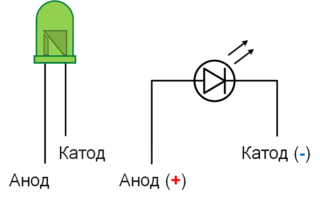
To get acquainted with the switching diagrams and wiring of the diode element, you need to find out what the pinout of the LED looks like. As its graphic designation, a triangle is used, to one of the corners of which a short vertical strip adjoins - in the diagram it is called the cathode. It is considered to be the output for direct current flowing in from the reverse side. There is a positive potential from the power source and therefore the input contact is called the anode (by analogy with vacuum tubes).
The LEDs produced by the industry have only two leads (less often - three or even four). There are three ways to determine their polarity:
- a visual method that allows you to determine the anode of an element by a characteristic protrusion on one of the legs;
- using a multimeter in the "Diode test" mode;
- by means of a power supply unit with a constant output voltage.
To determine the polarity in the second way, the positive end of the tester measuring cord in red insulation is connected to one contact terminal of the diode, and the black negative end to the other. If the device shows a forward voltage of the order of half a volt, the anode is located on the positive side. If the sign of infinity or "0L" appears on the display board, the cathode is located at this end.
When testing from a 12 Volt power supply, its plus should be connected to one end of the LED through a 1 kΩ limiting resistor. If the diode lights up, its anode is on the plus side of the power supply, and if not, on the other end.
Connection methods
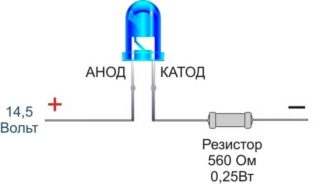
The simplest approach to solving the problem of reverse voltage inadmissible for a diode is to install an additional resistor in series with it, which is capable of limiting 220 volts. This element is called a quenching element, since it "dissipates" excess power on itself, leaving the LED 12-24 Volts necessary for its operation.
Installing the limiting resistor in series also solves the problem of the diode junction reverse voltage, which decreases to the same values. As a modification of series connection with voltage limitation, a mixed or combined circuit for connecting LEDs in 220 V is considered. In it, there are several parallel-connected diodes per resistor in series resistor.
The connection of the LED can be organized according to a scheme in which a conventional diode is used instead of a resistor, which has a high reverse breakdown voltage (preferably up to 400 volts or more). For these purposes, it is most convenient to take a typical product of the 1N4007 brand with an indicator of up to 1000 volts declared in the characteristics. When it is installed in a series circuit (in the manufacture of a garland, for example), the reverse part of the wave is rectified by a semiconductor diode. In this case, it performs the function of a shunt that protects the chip of the light element from breakdown.
Bypassing the LED with a conventional diode (anti-parallel connection)
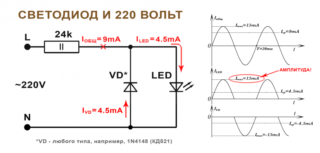
Another common variant of "neutralizing" the reverse half-wave is to use, together with a quenching resistor, another LED, which is connected in parallel and towards the first element. In this circuit, the reverse voltage is "closed" through a parallel connected diode and limited by an additional resistance in series.
This connection of two LEDs resembles the previous version, but with one difference. Each of them works with “its own” part of the sinusoid, providing protection against breakdown to the other element.
A significant drawback of the connection scheme through a damping resistor is a significant amount of unproductive power consumed by it idle.
This is confirmed by the following example. Let a damping resistor of 24 kΩ and an LED with an operating current of 9 mA be used. The power dissipated on the resistance will be equal to 9x9x24 = 1944 mW (after rounding - about 2 watts). In order for the resistor to work in optimal mode, it is selected with a P value of at least 3 W. On the LED itself, a very negligible part of the energy is consumed.
On the other hand, when using several LED elements connected in series, it is impractical to install a quenching resistor for reasons of their optimal luminescence mode. If you choose a very small resistance, it will quickly burn out due to the high current and significant power dissipation. Therefore, it is more natural for a capacitor to perform the function of a current-limiting element in an alternating current circuit, on which energy is not lost.
Capacitor limitation

The simplest circuit for connecting LEDs through a limiting capacitor C is characterized by the following features:
- chains of charge and discharge are provided to ensure the operating modes of the reactive element;
- one more LED is required to protect the main from reverse voltage;
- to calculate the capacitance of a capacitor, an empirically obtained formula is used, into which specific numbers are substituted.
To calculate the value of the nominal C, you need to multiply the current in the circuit by the factor 4.45 derived empirically. After that, the resulting product should be divided by the difference between the limiting voltage (310 Volts) and its drop on the LED.
As an example, consider connecting a capacitor to an RGB or ordinary LED diode with a voltage drop across its junction equal to 3 Volts and a current through it of 9 mA. According to the considered formula, its capacity will be 0.13 μF. To introduce a correction for its exact value, it should be borne in mind that the value of this parameter is more influenced by the current component.
The empirical formula worked out empirically is valid only for calculating the capacities and parameters of 220 V LEDs installed in networks with a frequency of 50 Hz. In other frequency ranges of supply voltages (in converters, for example), the factor 4.45 needs to be recalculated.
The nuances of connecting to a 220 Volt network
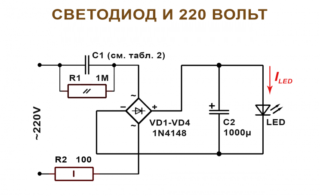
When using various schemes for connecting an LED to a 220 V network, some nuances are possible, taking into account which will help to avoid elementary errors in switching electrical circuits. They are mainly related to the amount of current flowing through the circuit when power is applied to it. To understand them, you will need to consider a simple device such as a backlight for decoration, consisting of a whole set of LED elements or an ordinary lamp based on them.
Considerable attention is paid to the features of the processes occurring in the circuit breaker at the moment of power supply. To ensure the "soft" mode of switching on, it will be necessary to solder a damping resistor and a LED indicator indicating the on state in parallel to its contacts.
The resistance value is selected according to the methods described earlier.
Only after the switch with a resistor in the circuit is the tape itself with the chips of the LED elements. It does not provide for protective diodes, so that the value of the quenching resistor is selected based on the current flowing through the circuit, it should not exceed a value of the order of 1 mA.
The LED indicator light in this circuit acts as a load, further limiting the current. Due to its small size, it will glow very dimly, but this is quite enough for the night mode. Under the action of the reverse half-wave, the voltage is partially extinguished across the resistor, which protects the diode from unwanted breakdown.
Ice driver circuit for 220 volts
A more reliable way to power the LEDs from the network is to use a special converter or driver that lowers the voltage to a safe level. The main purpose of the driver for a 220 volt LED is to limit the current through it within the permissible value (according to the passport). It includes a voltage driver, a rectifier bridge and a current stabilizer microcircuit.
Driver option without current stabilizer
- when using an output stabilizer, the ripple amplitude is significantly reduced;
- in this case, a part of the power is lost on the microcircuit itself, which affects the brightness of the glow of the emitting devices;
- when using a large-capacity filtering electrolyte instead of a proprietary stabilizer, the pulsations are not completely smoothed out, but remain within acceptable limits.
When making a driver yourself, the circuit can be simplified by replacing the output microcircuit with an electrolyte.
Connection security
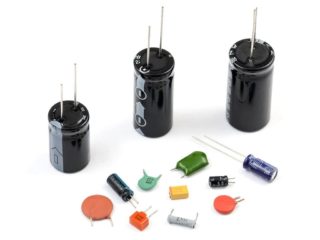
When working with a circuit for connecting diodes to a 220 Volt network, the main danger is a limiting capacitor connected in series with them. Under the influence of the mains voltage, it is charged to a potential hazardous to humans. To avoid trouble in this situation, it is recommended:
- provide a special discharge resistor chain in the circuit, controlled by a separate button;
- if this is not possible, before starting the tincture after disconnecting from the network, the capacitor should be discharged using the tip of a screwdriver;
- do not install polar capacitors in the diode supply circuit, the reverse current of which reaches values that can "burn out" the circuit.
It is possible to connect 220-volt LED elements only with the help of special elements introduced into the circuit additionally. In this case, you can do without a step-down transformer and power supply, traditionally used to connect low-voltage illuminators. The main task of the additional elements in the 220V LED connection circuit is to limit and rectify the current through it, and also to protect the semiconductor junction from the reverse half-wave.

